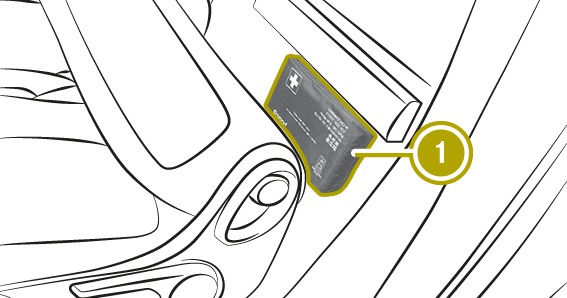- smart fortwo
- EQ fortwo
- 04/2021
The symmetrical low beam is needed in countries that drive on the other side of the road from the country of registration. Unlike the asymmetrical low beam, it does not dazzle oncoming traffic. The symmetrical low beam does not light up as much of the edge of the carriageway.

 .
.  .
. A flat tyre severely affects the driving characteristics as well as the steering and braking of the vehicle.
Tyres without run-flat characteristics:
Tyres with run-flat characteristics:
Damaged tyres can cause tyre pressure loss.
Insufficient tyre tread will result in reduced tyre grip.
The risk of aquaplaning is increased on wet roads, especially when the speed of the vehicle is not adapted to suit the conditions.
Summer tyres: 3 mm
M+S tyres: 4 mm
If you cannot avoid driving over obstacles, e.g. kerbs, do so slowly and at an obtuse angle only. The wheel rims and tyres could otherwise be damaged.
Check the tyre pressure More.
Visually inspect wheels and tyres for damage.
Check the valve caps.
The valves must be protected against moisture and dirt with the valve caps specially approved for the vehicle.
Visually check the tyre tread depth and the tyre tread over the entire width.
The minimum tyre tread depth for summer tyres is 3 mm and for winter tyres 4 mm.
the vehicle becomes grounded, e.g. on a high kerb or an unpaved road
the vehicle is driven too fast over an obstacle, e.g. a kerb, speed bump or pothole
a heavy object strikes the underbody or suspension components
In situations such as these, damage to the body, underbody, suspension components, wheels or tyres and high-voltage battery components may not be visible. Components damaged in this way can unexpectedly fail or, in the case of an accident, may no longer absorb the resulting force as intended.
Modification work on the brake system and wheels is not permitted. The use of spacers or brake dust shields is not permitted. This will invalidate the general operating permit for the vehicle.
Check the wheels and tyres for damage at least once a month, as well as after driving off-road or on poorly surfaced roads.
Run in new tyres at moderate speeds for the first 100 km. The tyres only attain their maximum performance after this distance.








The safety vest only meets the requirements defined by the legal standard if it is the correct size and fully closed when in use.
The safety vest must be replaced in the following cases:
it is damaged or dirt on the reflective strips can no longer be removed
if you exceed the maximum number of washes
if the fluorescence has faded
The safety vest is located in door stowage compartment  of the front passenger door.
of the front passenger door.

 .
. 
Warning triangle  is secured behind the driver's seat backrest with a Velcro fastener. Return it to this location after use.
is secured behind the driver's seat backrest with a Velcro fastener. Return it to this location after use.
 .
. Check the expiry date on the first-aid kit at least once a year. Replace the contents if necessary, and replace any missing parts.

First-aid kit (soft-sided)  is secured behind the driver's seat backrest with a Velcro fastener. Return the first-aid kit (soft sided) to this location after use.
is secured behind the driver's seat backrest with a Velcro fastener. Return the first-aid kit (soft sided) to this location after use.
 .
.